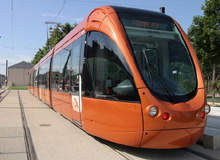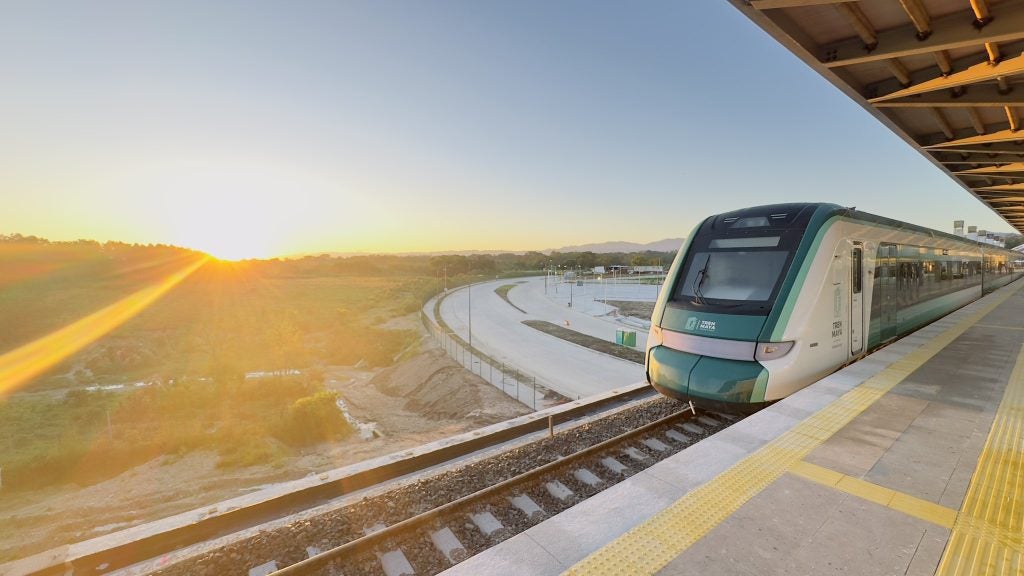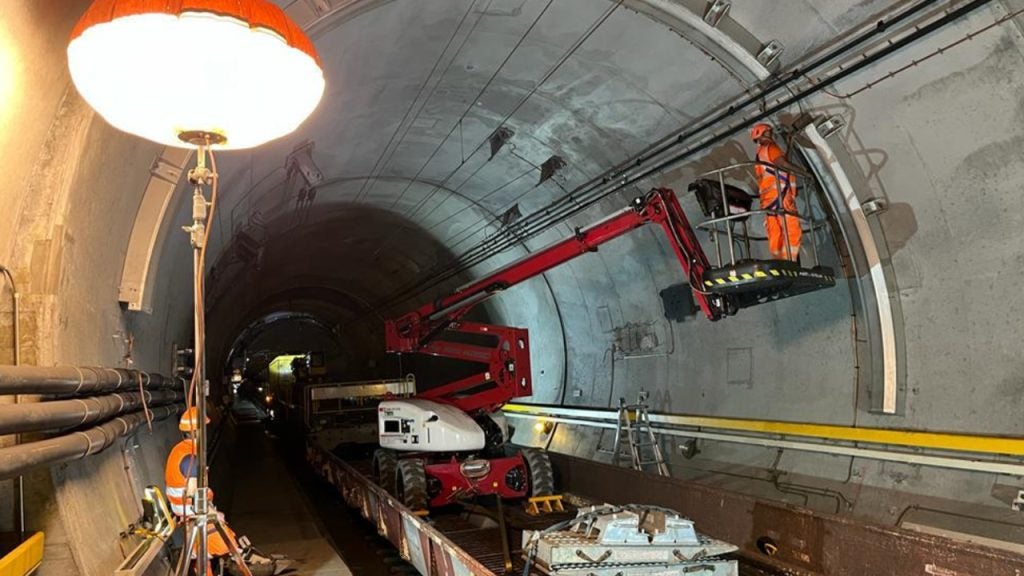
The year 2007 has been all about smashing records, opening new frontiers and finding ways to grow in a world ever more conscious of climate change and the benefits of alternative fuels.
Efforts in every sector of rail around the globe are moving full steam ahead. From India to Spain, the US to the UK, some of the largest projects to date are taking place.
FRENCH BREAK RECORD SPEED
When it comes to speed, the rail industry was not let down in 2007. The world rail speed record was smashed yet again on 3rd April 2007 in France, when an experimental Alstom 'V150' TGV achieved 574.8km/h (357.2mph) at Chemin between Champagne and Ardennes on the LGV Est Paris-Strasbourg route.
The train was specially modified with aerodynamic body streamlining, additional powered axles and larger wheels. At one stage its speed of 150m/s gave passengers on board the same sensation as an aircraft at take-off.
The restructured Alstom company needs good publicity like this. While domestic orders for TGVs are sustaining its factories at present, it hopes to attract serious interest from Argentina, China and Italy. In the US, a high-speed link between Sacramento, San Francisco, Los Angeles and San Diego powered by Alstom trains is also a possibility.
See Also:
The overall world 'rail' speed record remains at 360.8mph (581km/h), reached in December 2003 by a Japanese Maglev (magnetic levitation) train. However, this type of traction does not run on fixed tracks.
How well do you really know your competitors?
Access the most comprehensive Company Profiles on the market, powered by GlobalData. Save hours of research. Gain competitive edge.

Thank you!
Your download email will arrive shortly
Not ready to buy yet? Download a free sample
We are confident about the unique quality of our Company Profiles. However, we want you to make the most beneficial decision for your business, so we offer a free sample that you can download by submitting the below form
By GlobalDataHIGH SPEED IN THE UK
London, one of the world's most significant economic centres and home to seven million people, secured the UK's 186mph high-speed mainline link to Europe in November 2006.
The high-profile opening of St Pancras International Station boosted the service in November this year, following the opening of Eurostar's own record-breaking service from St Pancras to Brussels.
What was less reported is that the £5.8bn line through the Channel Tunnel to Paris, Lille and Brussels is only initially running at around 10% of capacity. However, this will be improved slightly at the end of 2009, when 140mph domestic services are introduced.
Rail freight business remains virtually non-existent, but Eurotunnel is hoping that reduced charges will kickstart a revival.
INDIAN RAIL EXPERIENCES DELAYS
As projects were praised for being completed on time, and breaking records in Europe, India's ambitious project to connect Kashmir with the Himalayan foothills reached the end of 2007 with major delays.
The expected opening of the principal section of the 290km route, which crosses major earthquake zones and is subjected to extreme temperatures, was put on hold. August 15, India's Independence Day, came and went without the running of the first train because of problems with
signalling systems.
The ambition to create a direct link to Delhi was first aired in 1898, but it was not until 2001 that the Indian government agreed to the $2.5bn project. Its 20 tunnels and 158 bridges make it a world-class project. The first 54km part of the route was opened in 2005.
CHANGES IN CHINA AND GLOBAL GROWTH
While India put its projects on hold, China's passenger and freight transportation used 2007 to open the country up to foreign capital for the first time. China, now just a few months away from staging the Olympic Games, has a staggering appetite for new investment, which alone accounts for a sixth of total world business.
China has never lost its passion for rail, and its national plan is to expand its present network of 75,000km to 100,000km by the end of the next decade.
On the topic of growth, the UK continues to top the league for the most rapid increase in passenger business. Followed closely by Ireland and Belgium, it has chalked up more than 40% growth over the last decade.
It may be a surprise to learn that business across France is up by a lesser (but still impressive) 35%, trailed by Spain, Germany, Denmark and Switzerland in the 20–30% area. The poorest performers are Portugal (down by around 25%) and the former Eastern bloc countries of the
Czech Republic and Poland, where the new freedom of the motor car is still being enjoyed.
LIGHT RAIL RENAISSANCE
The world light rail renaissance approached its 30th anniversary, with the opening of the 125th system worldwide since Edmonton in Canada first took the plunge in 1978.
Systems commissioned during 2007 were in Adana (Turkey), Almada (Portugal), Buenos Aires (Argentina), Cagliari (Italy), Charlotte (US), Le Mans (France), Madrid (Spain), Marseille (France), Murcia (Spain), Nice (France), Padova (Italy), Parla (Spain), Santa Cruz de Tenerife (Spain), Sevilla (Spain). A rubber-tyred system also opened in Tjanjin (China).
A further 27 tramways are under construction, and another 44 'heritage' lines can also be added to the list. In future, the concept of 'light rail' will be harder to define because of increasing interest in tram-trains.
Judging by the number of official delegations to Kassel, Germany, where public transport runs directly on rails into the town centre, this is a transport mode with a serious future.
France and the US continue to lead the revival with 17 new systems under their belts, and it is only in the former communist countries that a few system closures are still taking place.
ENVIRONMENTAL ASPECTS
Throughout the last year, serious trials have been conducted with alternative 'green' biofuels. Hoever, these have prompted mixed reactions from environmentalists. Despite offering reductions in carbon emissions, biofuels are being roundly criticised for a counterproductive increase in the destruction of rain forests in the Far East to make space for palm oil trees, soaring grain prices and new threats to water supplies.
In the UK, Virgin Trains entrepreneur Sir Richard Branson launched his first biodiesel train in June 2007. The aim was to attract worldwide interest in the employment of a modified conventional train powered by a 20% vegetable oil fuel mix, which can reduce an engine's carbon emissions by a seventh.
Whichever way you look at it, the dire warnings of climate change are beginning to strike home, and the year 2007 will be remembered by many as a watershed year. Governments worldwide are realising that efficient rail transport can make a positive contribution to the survival of the human race.
Spiralling petrol pump prices following a near-50% increase in crude oil costs are persuading the population to rethink their travel habits.
It is also dawning on the freight industry that road haulage can only prosper in the long term if lorries are made bigger to carry far more.
This is not possible without unaffordable investment in better infrastructure, so the answer for freight may be a return to rail.
RAIL PLANS IN 2008
How to accommodate growth in rail is a big challenge for the industry in 2008. Capacity improvements involving modest levels of expenditure are possible, though carefully planned infrastructure enhancements cannot allow growth to be accommodated efficiently.
The trappings for the global manufacturing industry are potentially immense, with the total market valued at around $75bn, of which the rolling stock and services sectors account for almost three quarters.
In the US, there are 200 train companies alone, competing for 1,000 locomotive orders and 60,000 wagons annually; this represents the renewal of around 3% of the total fleet. Economies can be secured by operators prepared to re-engineer existing stock for a new role.
As well as the large projects like Crossrail in the UK, India's rail growth, China's increased investment and the continued light-rail boom around the world, expect 2008 to come with a string of environmentally friendly challenges and outcomes, as the industry continues to be buoyed by rising demand, increased costs and even more competition.







